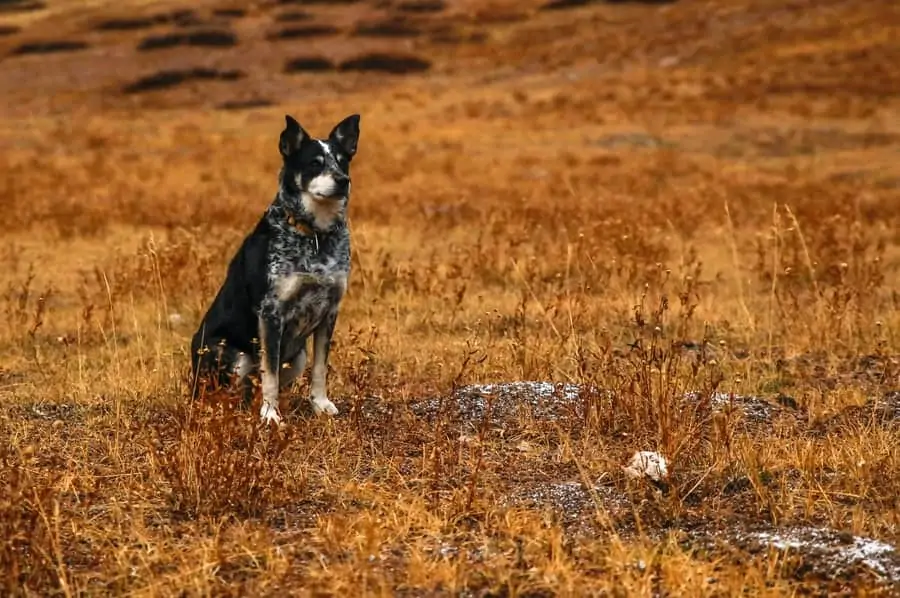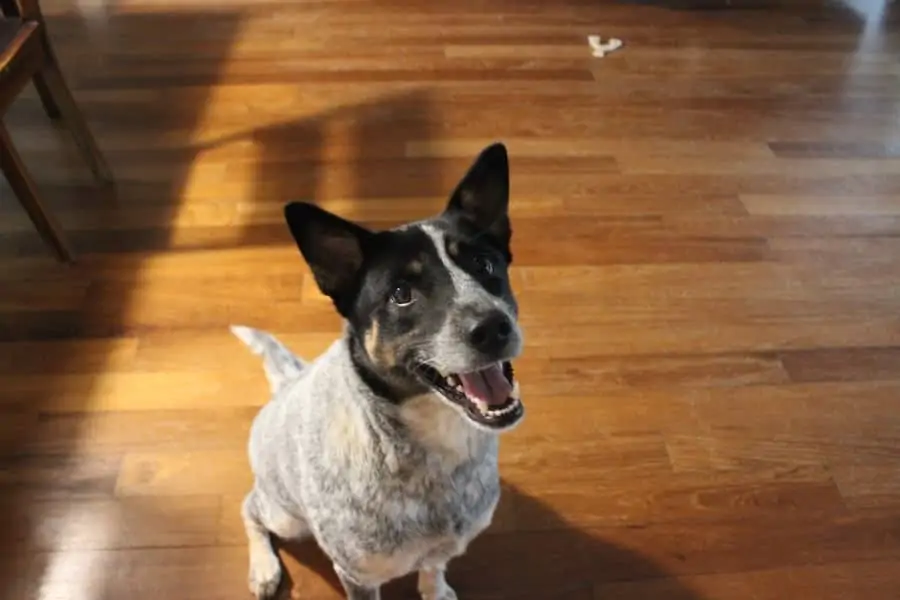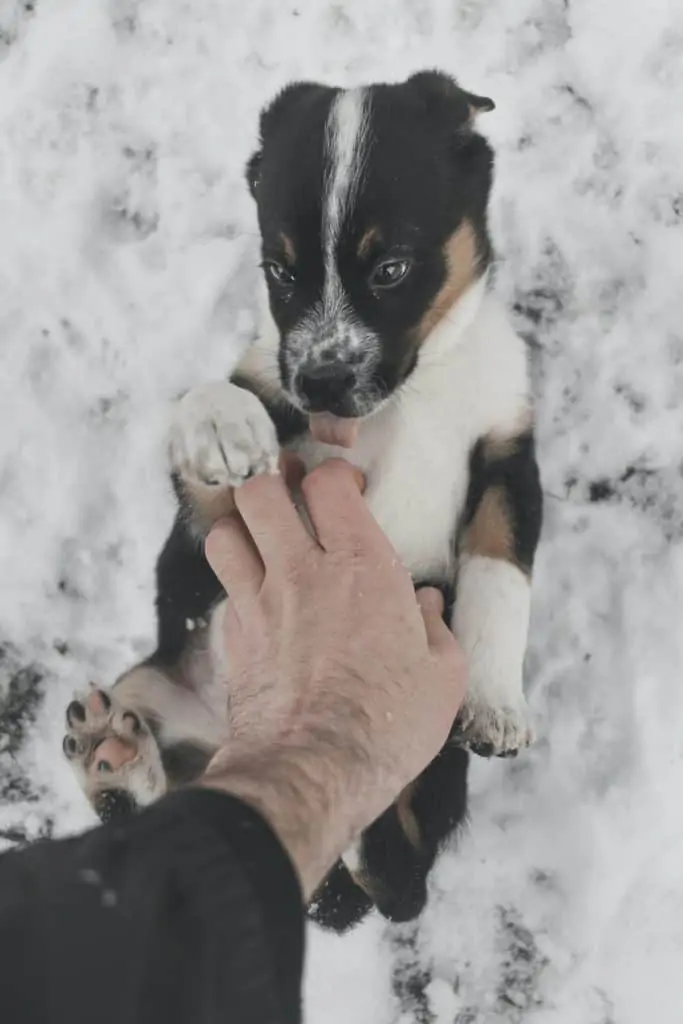Also known as the Australian Cattle Dog or Queensland Heeler, the Blue Heeler is a staple of the Australian beef market and has earned fame for being closely related to Australian’s wild Dingos.
But there is so much more to this incredible and intelligent purebred that makes him an outstanding companion and dog for the right owner. Are you interested in the Blue Heeler? Then this is the article for you.
Today we are going to discuss the Blue Heeler in detail and help you decide whether or not this would be the right dog for your home and lifestyle.
Let’s get started!
Contents
The Blue Heeler Breed Standard
Blue Heelers are medium sized working dogs with loads of energy.
The Blue Heeler of today is the work of refined and careful breeding throughout history. He was created to be one of the world’s most prized herding and working breeds in Australia, and boy did he rise to the occasion. However, while the Blue Heeler can make a wonderful companion, he can also come with some challenges.
But before we get into what it might be like to own a Blue Heeler, let’s first take a look at this breed’s standard, according to the American Kennel Club.
Origin: Australia
Group: Herding Group
Trainability: Moderate
Energy Level: High
Exercise Requirements: High
Temperament: Intelligent, Athletic, Devoted, Curious
Shedding Level: Moderate
Grooming Needs: Moderate
Height: 17-20 Inches
Weight: 35-50 Pounds
Coat: Short, Shedding
Coat Color: Blue, blue speckled, blue mottled, red mottled, red speckled, and markings that include tan markings, red markings, or black and tan markings.
Blue Heeler Overview:
Ranking in at number 50 out of 197 on the American Kennel Club’s list of America’s Most Popular Dog Breeds, the Blue Heeler is a farmer’s favorite when it comes to versatile jobs like herding, hunting, and guarding.
The Blue Heeler is a medium-sized breed known for his quick wit, incredible intelligence and devotion to family. When properly trained and socialized, the Blue Heeler makes a wonderful companion for the right owner.
However, if not raised correctly, this clever breed can be prone to destructive tendencies and serious behavioral issues. Blue Heeler dogs are best suited for experienced dog owners who have a good understanding of working breeds and owners who are available and flexible enough to provide their dog with time, attention and lots of exercise.
Coming in a variety of coat colors and markings, Blue Heeler Dogs are well-built and muscular. They have erect, pointed ears, bright eyes, and a long tail.
Clubs that Accept The Blue Heeler:
- The American Kennel Club (AKC)
- The Australian Cattle Dog Club of America (ACDCA)
- The United Kennel Club (UKC)
Blue Heeler History and Origin
Blue Heelers originated in Australia and are related to wild Dingos.
More commonly referred to as an Australian Cattle Dog, the Blue Heeler comes from a combination of different breeds. Most remarkably, the Blue Heeler is famous for being the descendant of Australia’s wild Dingos.
These feral dogs, along with other breeds like Dalmatians, Smithfields, Scottish Highland Collies, and Black and Tan Kelpies, help to create the Blue Heeler’s dynamic intelligence, athleticism, and devotion.
The call for a clever and hard-working herding breed arose early in the 1800’s when Australian migrants settled in the west, where grasslands and climate made the ideal environment for raising cattle.
As the cattle ranches grew, so did the need for an athletic, courageous, and highly intelligent herding dog capable of combating the rough terrain and weather, and with the ability to think for themselves, deter predators, and protect their property.
Years of breeding and perfecting went into creating the Blue Heeler we know and love today, and it’s due to these careful breeding practices that the Blue Heeler continues to be one of the most popular herding dogs to date.
Today, the Blue Heeler is recognized as playing a pivotal role in Australia’s beef market and economy. He continues to be employed as a versatile working dog throughout the world and is a top competitor in dog sports and shows.
Understanding The Top Five Traits Of A Blue Heeler
Blue Heelers are energetic and work-oriented.
Blue Heelers are highly sought after as family companions due to their amazing intelligence. Unfortunately, Blue Heeler dogs are not low maintenance, which has led to many of these breeds being surrendered to shelters or rescues.
For this reason, it’s imperative that you consider the common traits of a brainy working breed like the Blue Heeler before deciding to commit to one.
With that in mind, let’s take a look at the top five traits of working breeds like Blue Heelers that you should be aware of.
1 – Intelligence
One of the most intriguing traits of the Blue Heeler is his incredible mind. This is a dog who is an excellent and independent problem solver. Originally bred for herding, hunting and protecting, the Blue Heeler knows how to think for himself and is able to make snap decisions.
He learns quickly and enjoys a challenge. For this reason, the Blue Heeler can be problematic for novice owners. In fact, Blue Heeler dogs are commonly known to get themselves into mischief if they become bored and are prone to outwitting owners who make the mistake of underestimating them.
Potential owners should prepare to work with their Blue Heeler to establish a tight and trusting bond. This will help reduce behavioral issues, increase the effectiveness of training sessions, and will help you to keep your Blue Heeler on his best behavior.
2 – Work-Oriented
Working dogs are, (no surprise), work-oriented. But just how work-oriented Blue Heeler dogs are may surprise you. In fact, the American Kennel Club describes the Blue Heeler as a dog who “loves a job above all else”.
This means he will not be satisfied without proper mental and physical stimulation and he is not suited for homes and owners looking for a lounge-about type of dog.
Instead, the workaholic Blue Heeler thrives when given a job or chore. He loves a challenge and will enjoy being helpful around the house.
Owners might consider taking advantage of this and training their Blue Heeler to help with routine chores like sorting laundry, bringing in groceries, loading the dishwasher, or even cleaning up toys.
3 – Devotion
Blue Heelers are quite devoted to their owners. In fact, it is not uncommon for a Blue Heeler to favor one person in particular in his family. This behavior has earned the Blue Heeler the nickname of a velcro-dog.
For this reason, it’s important for owners to understand that Blue Heelers are people-oriented and do best when they are around their family. They can be prone to depression, anxiety and behavioral issues if left alone for too long during the day, and are not the ideal dog for owners who are gone often or have busy schedules.
4 – High-Energy
Along with plenty of attention and mental stimulation, your Blue Heeler will also require daily physical stimulation in order to feel his best. This is a very high energy breed who requires daily walks several times a day and plenty of playtime in between. He will require a home with backyard space where he can run and play and an owner who is active and outdoorsy.
Agile and muscular, the energetic Blue Heeler makes a wonderful jogging companion. He also enjoys hiking, games of frisbee and swimming.
5 – Stubborn
Blue Heelers may be brilliant, but they are not the most easily trained dogs. This is due to their stubborn temperament, which can be exasperated by owners who utilize negative reinforcement training techniques or training techniques that are not kept fun and gamelike.
This dog enjoys a challenge but can become easily bored, so it will be important to work with your dog consistently and at an early age.
The Blue Heeler and Children – Is This A Good Match?
Blue Heelers can get along well with children, though they can have herding instincts.
Most Blue Heeler owners and enthusiasts agree that Blue Heelers are not known to be aggressive. That said, they can be mouthy and may nip or bite. This is due to their herding instincts, which come naturally to them and may be exacerbated by smaller children and animals in the home.
The good news is that Blue Heelers can make wonderful family companions and do well in homes with children and other pets they are raised with. However, it’s very important for owners to work with their Blue Heeler and nip any undesirable behaviors like herding instincts, resource guarding and rough play in the bud early on.
It’s also a good idea to work with children and teach them how to respectfully and appropriately behave around the family dog. Go over common canine body language with family and friends and monitor young children around your Blue Heeler to ensure everyone is getting along safely and happily.
When Blue Heelers are raised with children properly, they are playful, pleasant, and joyful companions. They will keep a watchful eye on their human siblings and are often very protective and affectionate.
The Importance Of Training and Socializing A Blue Heeler Dog
A Blue Heeler that is not properly socialized and trained is likely to suffer from serious behavioral issues.
All dogs require a certain amount of proper socialization and training at an early age in order to grow up happy and healthy. Properly socializing and training an intelligent and work-oriented breed like the Blue Heeler is especially important to ensure you raise a mentally-sound and well-behaved dog.
Socialization is most effective when it occurs during your Blue Heeler dog’s puppyhood. Socialization includes introducing your Blue Heeler to as many new people, places, sights, sounds, experiences and environments as possible.
Try and ensure that first impressions are positive for your Blue Heeler, and help him to explore his world at his own pace. Try and refrain from forcing a Blue Heeler into a situation that is obviously stressful or scary for him.
Doing so could lead to future behavioral problems that can be difficult to manage. We also suggest working with your Blue Heeler at an early age to get him used to being handled. Touch his paws, ears, nose, tail and other areas of his body often.
When it comes to training, remember that the Blue Heeler is a remarkably clever breed who will do best with lots of consistent training from an owner who is committed, patient and focused.
The Blue Heeler can have a tendency to become stubborn, as we mentioned above. This behavior is especially prevalent if your Blue Heeler becomes bored during training. To reduce stubborn behaviors, use positive reinforcement training techniques like treats and praise as opposed to punishment and scolding.
Keep training short and game-like, and encourage positive behaviors with enthusiasm and excitement. Blue Heelers will also enjoy learning many more cues aside from the basics like sit, stay, and lie down.
Once you get past the basics and you find a training rhythm with your Blue Heeler, it will be easy and enjoyable to transition into much more complicated training sessions, tricks and sports.
Training will also be more fun and productive for you and your Blue Heeler if you invest in high quality treats like the training treats listed below.
Zuke’s Mini Training Treats
No products found.
Zuke’s Training Treats are bite-sized, chewy and healthy treats that are smelly and highly palatable, making them the ideal treats to use with your Blue Heeler. They come in a variety of flavors including chicken, turkey and cranberry, turkey and pumpkin, beef, duck, rabbit and salmon.
What we like most is that these treats are small, so they are perfect for routine training sessions. They are safe for dogs and puppies during all their life stages and are only three calories per treat, making them a low-calorie snack for your dog.
Blue Heeler Exercise and Mental Stimulation Requirements
Blue Heelers are high-energy dogs who need lots of routine exercise.
Are you looking for a low-key dog who will go with the flow and spend most of his day napping? If so, you’re not looking for a Blue Heeler. These dogs are constantly on the go and need just as much exercise as they do mental stimulation.
Staying busy will help satisfy their urge to work and will reduce the chances of potentially destructive issues or behavioral problems.
A good exercise routine for a Blue Heeler dog will include multiple walks a day and even a run or jog in the morning or afternoon. They will also thrive with a big, securely fenced backyard where they can run and play freely.
Along with this free playtime, it’s important that owners incorporate training into exercise and play routines. Games like frisbee can help keep your dog fit while setting up agility courses in the yard can help keep your dog’s mind engaged and challenged.
Plus, these activities can help you to bond with your dog and will lead to a more productive and fulfilling relationship in the long run.
In order for you and your Blue Heeler to get the most out of your exercise and mental stimulation sessions, we suggest investing in the right products.
We have even listed some of our favorites for you to consider below.
PetSafe 3-in-1 Dog Harness
No products found.
The PetSafe 3-in-1 Dog Harness is designed for athletic dogs who have the potential to get ahead of themselves during walks. These no pull harnesses specifically help reduce pulling by redirecting your dog gently back to you without putting pressure on his throat or trachea.
This harness is also a 3-in-1 harness, so it can be used for all your traveling, walking or exercise needs.
This unique dog harness clips in front for safe and comfortable walking while also coming with a seatbelt handle to be used as a seatbelt during car rides. Best of all, it is an excellent dog harness for running or jogging, which we know Blue Heelers love to do.
Our Pets Puzzle Toy Game
No products found.
Very intelligent dogs like Blue Heelers require lots of mental stimulation, especially when their owners are away. The best puzzle toys utilize treats or food to help keep your Blue Heeler engaged and busy.
The above puzzle toy by Our Pets is designed to hide treats and encourages your dog to move panels in order to locate the hidden tasty treasures. This toy can be ordered in different styles and you can even use it as a slow feeder as well as a puzzle toy to encourage healthy eating habits.
Bestio Treat Dispenser
No products found.
Another puzzle toy we like that can help keep your Blue Heeler entertained is the above interactive treat dispenser by Bestio. The dispenser is designed to wobble as your dog plays with it, releasing treats as it moves.
The toy comes in three different colors and is made of dog save materials free of toxic ingredients or stinky odors. It is easy to clean and will be most effective when it is used on special occasions or when you are leaving for extended periods of time.
The Blue Heeler Grooming Needs
Blue Heeler dogs are short coated dogs who are easy to groom and maintain.
Although it is true that Blue Heeler dogs are more high maintenance than many other canines when it comes to training, exercise and mental stimulation, they are actually low maintenance when it comes to grooming care.
These short coated dogs have weather resistant coats that shed year-round, but only minimally. The exception to this would be during shedding season in spring and fall, when the Blue Heeler sheds more heavily.
For most of the time, your Blue Heeler will do well brushed over a few times a week with a slicker comb or deshedding tool like the one listed below.
Hertzko Self Cleaning Slicker Brush
No products found.
A slicker brush is an important tool for any owner of a Blue Heeler. While Blue Heeler dogs are not the heaviest of shedders, they are shedding dogs who are active and playful. This slicker brush can help remove loose hair and debris while also helping to promote the natural oils in your Blue Heeler’s skin.
The Hertzko brush above is a self-cleaning slicker brush that is easy to use and can be used every day if necessary.
During shedding season, you may need to brush your Blue Heeler more frequently to reduce the amount of loose hair that builds up in their fur. Still, this breed does not need to get haircuts or trims and he only needs bathing occasionally.
It’s important not to overbathe your Blue Heeler, as doing so can disrupt his natural PH balance and lead to skin issues and patchy fur. When you do bathe your Blue Heeler, make sure you use a quality, dog-safe shampoo and conditioner free of alcohol or dyes.
Along with routine brushing and occasional bathing, the Blue Heeler should also have his nails trimmed regularly to keep them from cracking and splitting. His ears should be checked and cleaned often to keep them free of buildup and moisture that could potentially cause ear infections, and the teeth should be brushed at least once a day with a dog-safe toothbrush and toothpaste.
Keeping up with routine grooming maintenance not only helps keep your dog looking his best, but it will also help keep him feeling his best. Plus, routine grooming can help increase his lifespan and may even assist you in catching potential health issues early.
Blue Heeler Lifespan and Health Issues
Blue Heelers can live for up to 16 years.
Although the Blue Heeler is a long-lived dog, he can be prone to a number of serious genetic health issues that a potential owner should be aware of.
Blue Heeler Lifespan: 10 – 16 Years
Blue Heeler Health Issues:
- Canine Hip Dysplasia
- Elbow Dysplasia
- Progressive Retinal Atrophy
- Osteochondroisis Dissecans
- Deafness
- Lens Luxation
- Von Willebrand’s Disease
- Cataracts
- Persistent Pupillary Membrane
- Ear Infections
- And Dental Disease
You can help combat potential health issues in your Blue Heeler by ensuring you get your puppy or rescue dog from a reputable source.
You might also consider having your Blue Heeler health screened. According to the National Breed Club, the Blue Heeler should be health screened for the following:
- Hip and Elbow Evaluation
- Ophthalmologist Evaluation
- PRA Optigen DNA Test
- PLL DNA test
- And BAER Testing
Along with health screening, there are other steps you can take when it comes to raising a happy and healthy dog.
Keep Your Blue Heeler On A Quality Diet
All dogs require a high quality dog food that is specified for their age, weight and activity level. For a medium sized dog like the Blue Heeler, a good dog food would be one that is specified for medium sized dog breeds and that is rich in real animal protein, fatty acids, carbohydrates, vitamins, minerals, and is a good source of water.
There are different types of dog food available for your Blue Heeler, including raw dog food, wet dog food and dry dog food. You also have the option of making homemade dog food.
All types of dog foods available have their own pros and cons, so it’s important to speak with your veterinarian and do plenty of research before deciding which kind of dog food would be best for your Blue Heeler.
Keep Up With Daily Exercise and Mental Stimulation
Exercise and mental stimulation will help reduce stress and anxiety in your Blue Heeler, which can help boost the immune system and keep illnesses at bay. Starting early with a proper exercise routine will also help aid in healthy development and increase bone, joint and muscle health.
Schedule Routine Vet Visits
Keeping up with routine vet visits is one of the best ways to keep on top of your dog’s health. Just like people, dogs should be seen for wellness exams at least once a year. As they age, some veterinarians may want to see them twice a year.
Staying on top of veterinary visits can help diagnose certain illnesses early on, catching them before they become too serious. This will not only increase your Blue Heeler’s quality of life, but it can also help save you money in the long run.
Don’t Slack On Grooming Practices
Last but not least, it’s important to keep up with routine grooming. Dental disease is one of the leading causes of health issues in dogs, and this is something that can be avoided when proper attention is given to the mouth, gums and teeth.
Routine brushing, ear cleaning, and nail trimmings will also help keep your Blue Heeler healthy and happy.
Your Blue Heeler – How To Pick A Healthy Puppy or Rescue
Make sure not to cut corners when looking for a blue heeler puppy or rescue.
Are you considering getting a Blue Heeler dog? If so, you’ll want to make sure you get your puppy or rescue from a reputable source.
If you’re looking for a puppy through a breeder, be prepared to spend between $500 to $5,500. This price can vary depending on the breeder you go through and the quality of your Blue Heeler puppy’s parents.
Remember, the Blue Heeler is routinely used in competitions and many are still employed as ranch dogs. This means that puppies born to show quality or working quality parents can be quite valuable. However, puppies bred for companionship are generally affordable and around the $500 range.
While some Blue Heeler puppies can be costly, it’s best you stay away from backyard breeders or unqualified online sellers in the hopes of saving a few dollars. Doing so could mean you are much more likely to wind up with a sick puppy or a dog who grows up to have behavioral issues.
You might also consider rescuing a Blue Heeler. In fact, there are several rescue organizations that are devoted to the breed throughout the United States. This is great news if you are not only looking to save some money but also looking to offer a dog in need a good and loving home.
Many shelters cost a fraction of the price of breeders. Plus, they will often have their dogs undergo behavioral testing before placing them for adoption. Some rescues even offer free initial vet exams.
And remember, Blue Heeler dogs may not be the lowest maintenance dogs as far as temperament, training and exercise, but they are incredible canines who, when paired with the right owner, will surely be worth all the hard work and commitment.
We hope this has been a helpful guide on the Blue Heeler and that you’ve been able to decide if this would be the best dog for you.
If you do end up with a Blue Heeler dog, keep us posted!
Best of luck and thanks for reading!


Jen Jones is a professional dog trainer and behavior specialist with more than 25 years of experience. As the founder of ‘Your Dog Advisor’ and the ‘Canine Connection’ rehabilitation center, she applies a holistic, empathetic approach, aiming to address root causes rather than merely treating symptoms.
Well known for her intuitive and compassionate approach, Jen adopts scientifically-proven, reward-based methods, encouraging positive reinforcement over punishment. Jen specializes in obedience training, behavior modification, and puppy socialization. Her innovative methods, particularly in addressing anxiety and aggression issues, have been widely recognized. Jen has worked with many of the world’s leading dog behaviorists and in her free time volunteers with local animal shelters and rescue groups.









